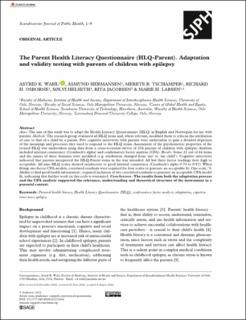| dc.contributor.author | Wahl, Astrid Klopstad | |
| dc.contributor.author | Hermansen, Åsmund | |
| dc.contributor.author | Tschamper, Merete B. | |
| dc.contributor.author | Osborne, Richard H. | |
| dc.contributor.author | Helseth, Sølvi | |
| dc.contributor.author | Jacobsen, Rita | |
| dc.contributor.author | Larsen, Marie Hamilton | |
| dc.date.accessioned | 2022-12-27T13:20:00Z | |
| dc.date.available | 2022-12-27T13:20:00Z | |
| dc.date.created | 2022-11-23T08:36:30Z | |
| dc.date.issued | 2022 | |
| dc.identifier.citation | Scandinavian Journal of Public Health. 2022, . | en_US |
| dc.identifier.issn | 1403-4948 | |
| dc.identifier.uri | https://hdl.handle.net/11250/3039556 | |
| dc.description.abstract | Aims: The aim of this study was to adapt the Health Literacy Questionnaire (HLQ) in English and Norwegian for use with parents.
Methods: The research group evaluated all HLQ items and, where relevant, modified them to refocus the attribution of care to that of a child by a parent. Five cognitive interviews with parents were undertaken to gain a detailed depiction of the meanings and processes they used to respond to the HLQ items. Assessment of the psychometric properties of the revised HLQ was undertaken using data from a cross-sectional survey of 254 parents of children with epilepsy. Analysis included internal consistency (Cronbach’s alpha) and confirmatory factor analysis (CFA). Results: Some 22 out of 44 items and the names of three domains were modified (e.g. attribution changed from ‘me’ to ‘my child’). Cognitive interviews
indicated that parents interpreted the HLQ-Parent items in the way intended. All but three factor loadings were high to acceptable. All nine HLQ scales showed satisfactory to good internal consistency (Cronbach’s alpha 0.70 to 0.87). When fitting one-factor CFA models, correlated residuals were required for four scales to generate an acceptable fit. One scale, ‘8. Ability to find good health information’, required inclusion of two correlated residuals to generate an acceptable CFA model fit, indicating that further work on this scale is warranted. Conclusions: The results from both the adaptation process and the CFA analysis supported the relevance, understanding and theoretical structure of the instrument in a
parental context. | en_US |
| dc.language.iso | eng | en_US |
| dc.rights | Navngivelse-Ikkekommersiell 4.0 Internasjonal | * |
| dc.rights.uri | http://creativecommons.org/licenses/by-nc/4.0/deed.no | * |
| dc.subject | Epilepsi | en_US |
| dc.subject | Helsekompetanse | en_US |
| dc.title | The Parent Health Literacy Questionnaire (HLQ-Parent). Adaptation and validity testing with parents of children with epilepsy | en_US |
| dc.title.alternative | The Parent Health Literacy Questionnaire (HLQ-Parent). Adaptation and validity testing with parents of children with epilepsy | en_US |
| dc.type | Peer reviewed | en_US |
| dc.type | Journal article | en_US |
| dc.description.version | publishedVersion | en_US |
| dc.source.pagenumber | 0 | en_US |
| dc.source.journal | Scandinavian Journal of Public Health | en_US |
| dc.identifier.doi | 10.1177/14034948221123436 | |
| dc.identifier.cristin | 2078811 | |
| cristin.ispublished | true | |
| cristin.fulltext | original | |
| cristin.qualitycode | 1 | |

